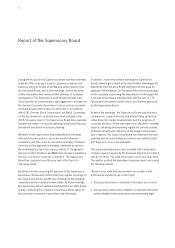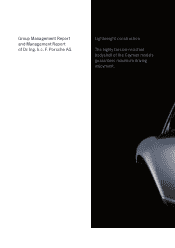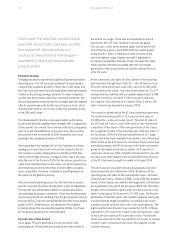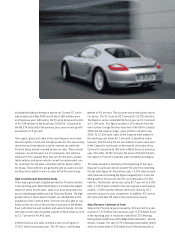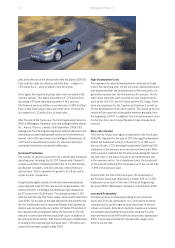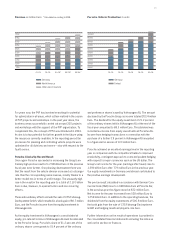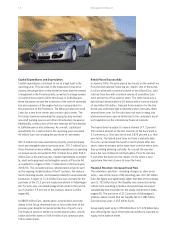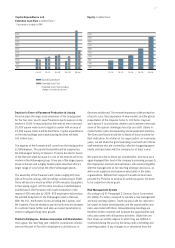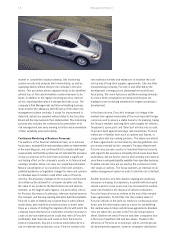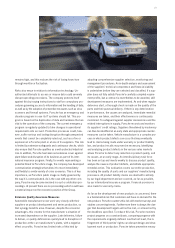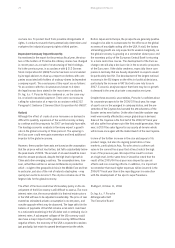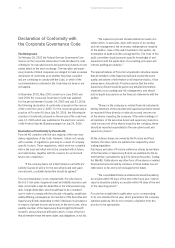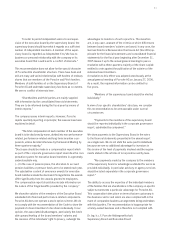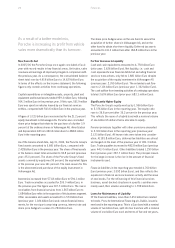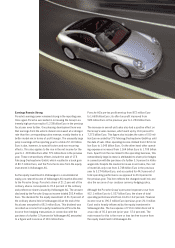Porsche 2005 Annual Report Download - page 20
Download and view the complete annual report
Please find page 20 of the 2005 Porsche annual report below. You can navigate through the pages in the report by either clicking on the pages listed below, or by using the keyword search tool below to find specific information within the annual report.
18
market or competitive situation develop, this monitoring
system records and analyzes them immediately, as well as
supplying details without delay to the company's decision-
takers. This procedure allows negative trends to be identified
without loss of time and immediate countermeasures to be
taken. In addition to the regular reporting process, internal
ad-hoc reporting takes place if unexpected risks occur. The
company’s Risk Management and Internal Auditing business
areas monitor the adequacy and efficiency of the entire risk
management system centrally. If scope for improvement is
detected, details are supplied without delay to the Executive
Board and the improvements then implemented. This monitoring
process also includes the continuous documentation of all
risk management and early warning activities and examination
of their suitability and practicability.
Continuous Monitoring of Business Processes
The auditors of the financial statements have, as in previous
fiscal years, evaluated the early warning system as implemented
in the reporting year, and confirmed that it complies with legal
requirements and that the system has not indicated the presence
of any occurrences at Porsche that could have a significant
and lasting effect on the company’s assets or its financial and
earnings situation. Risks can never be completely eliminated.
Natural catastrophes or an escalation of terrorist activities,
potential pandemics or legislative changes for taxes and customs
in individual export markets could affect sales of Porsche
vehicles. Recessionary changes to the economic environment
also influence the demand for consumer durables and thus
the sales of our products: the North American and German
markets, as the largest sales regions, are particularly critical
for Porsche. By means of continuous, intensive market observa-
tion, however, and the early warning indicators that it has installed,
Porsche is able to identify any incipient drop in sales without
undue delay, and modify its production plans or divert sales
flows as a means of limiting the negative effects with which the
company would otherwise be confronted. A further increase in
crude oil and raw material prices could also restrict Porsche’s
profitability. Raw materials and crude oil form the basis for
several components. Any price increase leads indirectly to a
rise in materials and production costs. Porsche monitors the
raw materials markets and endeavors to minimize the cost
risk by way of long-term supplier agreements. Like any other
manufacturing company, Porsche is also affected by the
development in energy prices stemming from market and
fiscal policy. The rise in fuel prices and the increasing demands
to reduce fleet consumption and exhaust emissions are
leading to ever-increasing standards for engine and product
development.
In the financial area, Porsche’s strategy is to hedge in the
medium term against movements of the most important foreign
currencies and to ensure a stable basis for its planning, taking
the Group’s medium- and long-term sales targets for vehicles,
Tequipment, spare parts and ‘Selection’ articles into account.
To protect itself against exchange rate movements, Porsche
makes use of familiar tools such as options and futures, in
cooperation with top-ranking partners. The nature and extent
of these agreements are laid down by internal guidelines and
processed centrally by the company’s Treasury department.
Porsche also pursues a policy of maximum financial security
with regard to the assurance of liquidity. Bond issues have been
undertaken, but are held in reserve and currently earn interest
since there is adequate liquidity available from operative business.
Possible interest risks are secured by the conclusion of inte-
rest swaps or options. The Group operates an intensive recei-
vables management system in order to limit the risk of default.
Another business area that requires ongoing precautionary
measures is leasing. Its expansion, in parallel with increased
vehicle sales for some years now, has increased the residual
value risk involved in the disposal of vehicles returned to
Porsche financial services entities at the end of the relevant
lease agreements. To limit this risk, the residual value of
Porsche vehicles in the used car market is continuously moni-
tored, and this information used as a basis for establishing
the residual value in future vehicle lease agreements. Residual
risks are taken into account in the Porsche Group balance
sheet. Another risk which Porsche and other companies face
is the loss of qualified staff and executives. Thanks to the
attraction of Porsche as an employer and its current person-
nel development programs, however, employee satisfaction
Management Report


